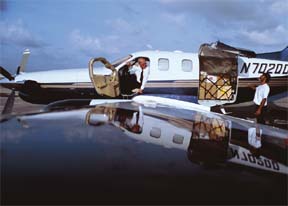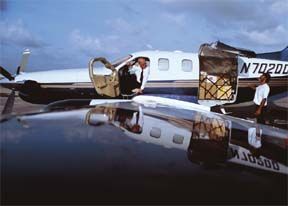
By Thomas P. Turner
Who hasnt been tempted to load just a bit more into an airplane? Early on, we all learned to keep the airplane loaded within its center-of-gravity limits and the weight below the maximum certified gross…yet we hear stories of airplanes being flown well above their maximum certificated weight, and numerous legal gross weight increases are commercially available. Over-gross operations are routinely approved under certain circumstances in Alaska and for airplanes being ferried overseas. So, how serious are an airplanes weight limitations and what happens when we exceed them? One word: performance.
Aircraft performance is particularly dependent on weight and any of several factors may determine the maximum weight number. For instance, in single-engine airplanes the weight must be low enough to provide a landing configuration stall speed below 61 knots. Climb performance and even engine cooling characteristics under adverse conditions are considered in determining max gross. In piston twins, the number may be artificially low to provide sufficient single-engine climb performance.
Whatever the airplane and whatever the max gross figure, exceeding it means well take a performance hit. How much of a hit will it be and how might it affect our operations? Read on.
Weight And Lift
You already know that, in order to climb, an airplane must generate sufficient lift to overcome its weight. Lift results from the wings angle of attack and, to an extent, power. The higher the airplanes weight, the more power and/or higher the angle of attack needed to lift that weight. Presuming were using the maximum power available for the given conditions, we need a higher angle of attack than normal to generate the lift necessary for flight at max- or above-max-gross weights.
The fly in the ointment is that maximum lift occurs at a specific angle of attack (AoA), and any different AoA (higher or lower) results in an increase in drag. Generated lift at the best AoA may not be enough to safely lift a weight above max gross. In fact, the certified maximum weight may well have been the maximum that is safe at best AoA. Takeoff and climb performance will suffer, as may the airplanes cruise characteristics.If you legally (or illegally, for that matter) increase your airplanes maximum takeoff weight, what performance might you expect as a result?
The High And The Low
By now, the link between power, weight and performance should be obvious. But having excess power does not necessarily mean we have the ability to operate safely above maximum gross weight in all airplanes and in all conditions all the time. For example, the sidebar on the opposite page details some of the issues we may encounter when we overload a twin-things might be just fine until one of the engines fails.
For another example, lets pick a normally aspirated airplane with a very good power-to-weight ratio, Diamonds DA40-180 Diamond Star, and look at its performance data to approximate what over-gross performance losses to expect.
But first, the disclaimer: Mathematically approximating the performance reduction at higher-than-maximum-gross weights is not encouragement to exceed aircraft limitations. Instead, this exercise is intended to show that the performance loss can be significant and to convince you to avoid over-gross conditions.
The DA40-180 climb chart reproduced on page 11 plots some calculations for cruise-climb performance data at different density altitudes, each at maximum takeoff weight and at 200 pounds below maximum. On a standard day at sea level, for instance, a DA40-180 pilot can expect about 1120 fpm climb at maximum takeoff weight, and 1250 fpm at about 200 pounds below max gross.
At a high density altitude (think Denver on a summer afternoon), the max gross DA40-180 should net about 880 fpm in cruise climb, or 1020 fpm at around 200 pounds less. Thats about a 10-percent difference in climb performance at sea level, and close to a 15-percent reduction on a hot day at DEN. Now lets extrapolate climb performance.
With the above as a very rough guide, we can reliably estimate the DA40-180 will lose between five and 7.5 percent of its climb capability for every 100 pounds above maximum gross weight. Although the airplane is a spectacular climber for its horsepower, the margin for error will drop rapidly with weights above max gross. If other adverse factors (obstacles, wind shear, partial power loss) impact the flight, the high aircraft weight will make a safe, successful outcome significantly more difficult to achieve.
This exercise also helps those whose airplanes have approved gross weight increases-but who have no revised performance data from the Supplemental Type Certificate (STC) holder-estimate the performance loss as a result of operating at those higher weights.
One airplane type with several options for approved weight increase is the Beech A36 Bonanza. With the A36, we can use the same technique of extrapolating theoretical takeoff and climb performance from existing POH data; some examples of the results can be found in the sidebar.
Once again we see a roughly five percent performance reduction for every 100-pound weight increase. This doesnt sound like very much until you look at the absolute figures. As density altitude climbs, its not unusual for it to take a half mile or more from the beginning of the takeoff roll to get to a point 50 feet in the air, assuming a POH-style takeoff-essentially a short-field technique. Again, the lighter the airplane operating weight that allows sufficient fuel and reserves, the better.
The punchline is let no one tell you a gross weight increase comes without a penalty. AOPA Pilot magazine recently quoted the book Axioms of Flight as saying that for every 10 percent change in airplane weight, there will be a corresponding 21 percent change in performance. Unless power is significantly increased as part of a weight-increasing STC, you will need a longer runway and you will climb less quickly if you take advantage of the gross weight increase.
Gross Weight STC?
As weve alluded, there are legal ways to increase an airplanes maximum gross takeoff weight. Modifications as simple as improved engine baffling, as complex as adding a turbocharger, and as utilitarian as tip tanks or vortex generators often permit a legal increase in takeoff weight. Such approval would be part of an STC for the modification. The STC holder can in turn grant that authority to airplanes modified under their STC. The newly authorized maximum weight is listed in the FAA-approved Limitations section in the POH Supplement for that STC.
But beware-rarely does a gross weight increase come with revised performance data. Until you establish a new baseline for performance, youre a test pilot-its up to you to figure out what works.
Most STCd weight increases approve a higher takeoff weight, but rarely do they include an increase in landing weight. Its common in airplanes above the size of most single-engine retractables to have a max takeoff weight higher than its max landing weight. A singles max landing weight is determined during certification in part by the need to achieve that 61-knot or lower stalling speed and in part by stresses on the airframe-especially the landing gear structure-during landings (especially if the landing is not as smooth as youd like).
Complying with such a restriction means you have to plan your heavy-weight flights so that you will land at less than the maximum certified landing weight.
Of course, in an emergency you may need to land now, regardless of aircraft weight. If you land at a higher weight than certified, its a good idea for a qualified mechanic to make a visual check of the landing gear, wings and tail, engine mounts, and wing attach/carry-through structure for any signs of overstress.
If youre considering an STC featuring a gross weight increase, ask the vendor to review with you all operational limitations to help you make an informed purchase.
Lets Review…
Since your primary training days, youve been taught the airplane will lift only so much weight safely. As weve seen, everythings relative-as weight increases, performance suffers and thats where the adverse impact on safety will be realized. Loading your airplane beyond what its designers intended might not kill you, but it can certainly make you wish youd offloaded those barbells.
Remember:
Any number of aerodynamic or power-related factors may decide an airplanes maximum takeoff weight.
As weight changes, so does performance. Expect it and plan for it, especially on summer days in Denver.
STCs can legally increase takeoff weight but, in most cases, they come with a takeoff and climb penalty and little guidance from the STC holder.
Flight above maximum gross weight is potentially hazardous, and weve used some frankly unproven assumptions to quantify those hazards. What we didnt discuss is the much more serious hazard arising when loading an airplane outside its center-of-gravity (c.g.) envelope. Youve got to put that extra weight somewhere, and in most cases that somewhere is in the aft cabin. A significant hazard of flight above max gross weight is that the c.g. location directly affects airplane performance, stall characteristics, stability and controllability. Well be looking at these effects in a future issue.
Also With This Article
“Double Trouble”
“High-Weight Techniques”
“Cruise Climb Performance”
-Tom Turner is a CFII-MEI who frequently writes and lectures on aviation safety.




